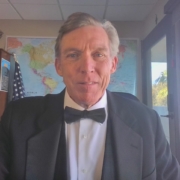How John Flannery Built a 20-Year Sales Training Success Story by Mastering Process
By Gerhard Gschwandtner, Founder and CEO of Selling Power Magazine
There’s a particular look that some entrepreneurs wear like a tailored suit. A mix of modest confidence and deep-seated grit. John Flannery wore that look when I sat down with him—plus an actual tuxedo, in honor of his company’s 20th anniversary.
Two decades of building a business from scratch. That’s rarefied air in the sales training world, where trends change with every algorithm tweak and buzzwords have shorter half-lives than TikTok memes. But Flannery isn’t a trend chaser. He’s a process guy. A clarity guy. The kind of leader who spotted a systemic flaw in big companies—that the larger the organization, the more cracks you’ll find in the sales process —and built a business to fix it.
“I had a good business once,” Flannery tells me, reflecting on his early ventures in wireless tech. “But the partnership didn’t work out.” That’s the sort of line that sounds easy in hindsight but stings in real-time. What followed was a stint working for someone else—a career detour that, for many entrepreneurs, feels like purgatory. But purgatory, as it turns out, is a great place to study the system. And Flannery noticed something: sales processes in big organizations were bloated, fragmented, and increasingly ineffective.
Then came a spark. A trainer he was working with introduced him to a nimble model for sales development. That moment? That was Flannery’s founding motivation. He didn’t just launch a company—he declared a war on complexity. And he armed himself with simplicity, repeatability, and, most of all, a repeatable, adaptable, highly effective process.
Early success came wrapped in grit. “I was 14 months in, still prospecting,” he recalls. Then, like a plot twist in a feel-good movie, a referral introduced him to the president of a scientific distribution company. What started as a one-year contract for 400 employees bloomed into a six-year partnership impacting over 1,100 people.
“That was the anchor tenant,” Flannery says. You can hear the gratitude in his voice. But also the strategy. He knew how to land a whale and build a processing ship around it.
Then came the pandemic—the great disrupter of handshakes in hotel sales conference rooms. Twenty-one in-person workshops, vaporized in a week. On March 12, Flannery was flying back from Philadelphia. On March 13, the country shut down. The old model—face-to-face training—was dead. Online video technology took off.
It could have been a death knell. Instead, it was a pivot. Flannery adapted quickly, transforming 15 of those 21 sessions into virtual trainings. “We had to get good behind the lights,” he says. And fast.
Now, the next tidal wave looms: artificial intelligence. While some view it as a threat to human touch, Flannery sees opportunity in its algorithmic prowess. “Coaching is where AI will lift us the most,” he tells me. His team is working with developers to embed AI into sales coaching—using machine intelligence to tee up the right questions, identify risk signals early, and accelerate pipeline movement before a human coach ever steps in.
This isn’t about replacing the human touch. It’s about preparing it.
As Flannery gears up for the third decade in his business, he’s not chasing novelty. He’s chasing effectiveness. That’s the difference. And maybe the key lesson.
In the end, John Flannery isn’t just building a better sales process. He’s building something more enduring: trust through structure, clarity through chaos, and momentum through meaningful work.
If you’re wondering what it takes to last 20 years in sales training, don’t just study his methods. Study his mindset.


